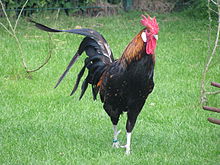Bergische Kräher
| Country of origin | Germany |
|---|---|
| Traits | |
| Weight | |
| Egg colour | white |
| Comb type | single |
| Classification | |
| EE | yes[3] |
| PCGB | rare long crowers[4] |
The Bergische Kräher[a] is a German breed of domestic chicken from the Bergisches Land, in the state of North Rhine-Westphalia in western Germany.[2][5] It is named for its unusually long crow, up to five times as long as that of other breeds, and belongs to the group of long-crowing chicken breeds, which are found from south-east Europe to the Far East.[6]
History


The Bergische Kräher has been bred in the
Today the Bergische Kräher is a rare breed. In 2001 it was an "endangered breed of the year" of the Gesellschaft zur Erhaltung alter und gefährdeter Haustierrassen,[11] and is listed in category I: extrem gefährdet, "extremely endangered", on the Rote Liste of that organisation.[12] In 2009, 77 cocks and 337 hens were recorded;[13] in 2013 the total population was 329.[5]
Characteristics
Only one plumage colouring is recognised, gold-laced black.[3][10]: 333 Hen birds are black with some gold markings on the wings and breast; cocks have gold neck-hackles and maroon markings on the wings. The black colour variety is extinct, black-silver coloured birds are extremely rare.[8] Like the Bergische Schlotterkamm, the Bergische Kräher shows typical broad lacing ("Dobbelung") of the breast feathers.[7] Cocks weigh 3–3.5 kg and hens 2–2.5 kg. The comb is single, the earlobes are white, and the legs are slate-blue.[7][10]: 333
Use
The Bergische Kräher is a dual-purpose breed, with good meat qualities. Hens lay about 130 white eggs per year, with an average weight of 56 g;[2] they have little tendency to broodiness.[6]
Cock crowing contests with Bergische Krähers have been a sport in the Bergische Land for centuries.[14] Since 1923, the breed society has organised annual crowing contests on Ascension Thursday[8]. In these – unlike in most traditional cock crowing contests in Germany, the Netherlands and Belgium – the crow is judged for its length and beauty, rather than for its frequency.[15]
-
Hen
-
The typical broad lacing (Dobbelung) of the breast feathers
-
Historical Illustration, Jean Bungartz, 1885
Notes
- ^ pronounced [ˈbɛʁɡɪʃə ˈkʁɛːɐ]; translatable as "crower of the Bergisches Land"
References
- ISBN 9789251057629. Accessed January 2017.
- ^ a b c d Rassetafeln: Bergische Kräher (in German). Bund Deutscher Rassegeflügelzüchter. Accessed August 2014.
- ^ a b Liste des races et variétés homologuée dans les pays EE (28.04.2013). Entente Européenne d’Aviculture et de Cuniculture. Archived 16 June 2013.
- ^ Breed Classification. Poultry Club of Great Britain. Archived 12 June 2018.
- ^ a b Breed data sheet: Bergische Kräher/Germany. Domestic Animal Diversity Information System of the Food and Agriculture Organization of the United Nations. Accessed August 2014.
- ^ a b c d Bergische Kräher (in German). Gesellschaft zur Erhaltung alter und gefährdeter Haustierrassen. Accessed January 2017.
- ^ a b c Schwerpunkt - Geflügel: Bergische Kräher (in German). Gesellschaft zur Erhaltung alter und gefährdeter Haustierrassen. Accessed August 2014.
- ^ a b c d Armin Six (2015). Bergische Kräher (in German). Gesellschaft zur Erhaltung alter und gefährdeter Haustierrassen. Accessed May 2019.
- ^ Edward Brown (1906). Races of Domestic Poultry. London: Edward Arnold.
- ^ ISBN 9781405156424.
- ^ Die gefährdete Nutztierrasse des Jahres 2001 (in German). Gesellschaft zur Erhaltung alter und gefährdeter Haustierrassen. Archived 23 November 2016.
- ^ Gemeinsame Liste alter und einheimischer Geflügelrassen in Deutschland der GEH und des BDRG (in German). Gesellschaft zur Erhaltung alter und gefährdeter Haustierrassen. Archived 2 February 2017.
- ^ Rote Liste: Einheimische Nutztierrassen in Deutschland 2013 (in German). Bundesanstalt für Landwirtschaft und Ernährung. Archived 1 February 2014.
- ^ Friedrich Wieden (1949). Die Geschichte der Bergischen Kräher. Deutscher Geflügelhof 43. Oldenburg.
- ^ Stefaan De Groote (27 June 2011). Hanenzettingen opgenomen in Vlaamse inventaris immaterieel erfgoed (in Dutch, "Cock crowing contest recognised as Flemish national heritage"). Het Nieuwsblad. Accessed October 2015.



